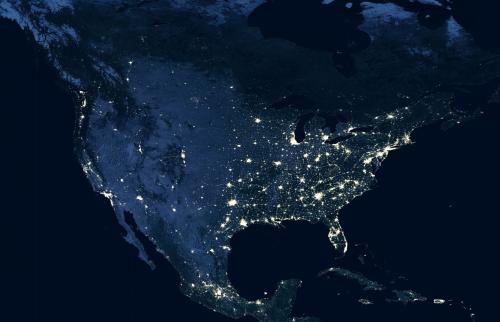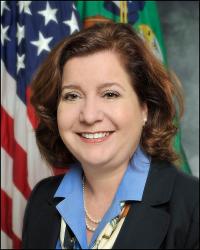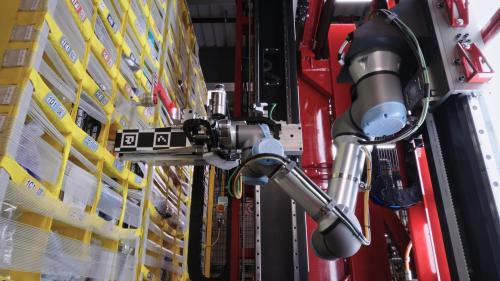In the mid-20th century, U.S. states experienced recessions very differently from one another, which resulted in many workers migrating between states in search of work. But a newly developed dataset shows that economic recoveries have begun to look very similar across states in recent decades. On this episode, Senior Fellow Louise Sheiner talks with Andrew Fieldhouse and David Munro, authors of a new BPEA study that produced this dataset, “The emergence of a uniform business cycle in the United States.” Their conversation with Sheiner explores the reasons behind the convergence in recession recovery and the policy implications.
Transcript
[music]
EBERLY: I’m Jan Eberly, the James R. and Helen D. Russell Professor of Finance at Northwestern University.
STEINSSON: And I’m Jón Steinsson, Chancellor’s Professor of Economics at the University of California, Berkeley.
EBERLY: We’re the co-editors of the, a semiannual academic conference and journal that pairs rigorous research and real-time policy analysis to address the most urgent economic challenges of the day.
STEINSSON: And this is the Brookings Podcast on Economic Activity, where we share conversations with leading economists on the research they do and how it will affect economic policy.
EBERLY: It’s always exciting for economists to see new data, and especially so when it reveals a trend that can inform how we respond to economic crises. On this episode, we’ll be hearing a conversation on a new paper that highlights such a data set and what it reveals about how business cycles vary across states in the United States. The paper, “The Emergence of a Uniform Business Cycle in the United States: Evidence from New Claims-Based Unemployment Data,” is by Andrew Fieldhouse of Texas A&M University, Sean Howard and Christopher Koch of Empirical Research Partners, and David Munro of Middlebury College. Andrew and David will join today’s discussion along with Brookings Senior Fellow Louise Sheiner.
STEINSSON: This is a paper that builds on a classic BPEA paper by Blanchard and Katz published in 1992 on regional evolution. That paper studied the response of regional economies to local shocks. One conclusion was that in- and out-migration was an important channel of the response. When local economies faced the negative shock, people eventually moved out of the area or vice versa with positive shocks.
However, the weakness of the Blanchard and Katz paper was that their key results, which have really shaped the subsequent literature, were based on only 12 years of data from 1978 to 1990. This is one of the places where the Fieldhouse et al. paper really improves things by developing the new data set on unemployment going back to 1947 at the state level. The authors are then able to leverage their much longer data set to reanalyze these questions.
EBERLY: And the results are striking. The migration response seems to have almost completely gone away since the 1980s, and business cycles have become much more uniform across regions. This is consistent with other work we’ve seen at BPEA, suggesting that worker dynamism has declined over time. But the new data look at the business cycle dynamics and the effect on state and regional economies.
STEINSSON: With that, let’s hand it over to Louise.
SHEINER: Thanks, Jan and Jón. Andrew, welcome to the podcast.
FIELDHOUSE: Thank you so much for having us on, Louise.
SHEINER: And David, welcome to the podcast as well.
MUNRO: Thanks so much for having us.
SHEINER: So, David, before we dive into the details, can you give us an idea of why you pursued this project? What the big picture of the project is about?
MUNRO: Sure. Happy to. So, in a macroeconomic context, there’s a lot of interesting stuff that happened before the 1970s, which is when the unemployment data we have as researchers becomes available to us. So, in our project, what we do is we digitize and collect data on unemployment claims before 1976 to have this extra three decades, almost, of the postwar U.S. economy to study. And importantly, this data spans the first six postwar recessions.
One of the other key motivating factors for this project is the fact that the unemployment rate is typically viewed as our best indicator of the overall health of an economy. And it’s very useful for studying business cycles.
In terms of why this data is very useful at the state level, you can leverage the fact that states are somewhat different to help tease out the economic relationships that you’re interested in in the data. Similar to the famous notion in a legal context of the 50 laboratories of democracy. That idea is the fact that, you know, all of these different regions in the U.S. are somewhat different, and you can kind of leverage these different laboratories to study the things you’re interested in studying.
And so that was sort of the main motivation for us is to, A, expand the historical availability of this important data series, and B do so at a state level so, we can leverage these differences across states to study different economic phenomenon.
SHEINER: Great. So, you basically created this data set of state unemployment rates going back much further than the official data. How did you do that?
MUNRO: So, as you noted, the unemployment rate series at the state level starts in 1976. So, we’re missing that big chunk of postwar U.S. economy. So, what we did was we started looking at what other government documents we could find this data in. And the Department of Labor has been collecting and reporting data on unemployment insurance claims since the 1940s. That data is only publicly available since the 1970s.
And so, what we did was we digitized that data up until the publicly available data exists in digitized form. So, we digitized about 36,000 monthly observations at the state level, and we then merged that with the existing Department of Labor data.
And in the paper, we show that this alternative measure of unemployment is very correlated and a very good proxy for the official unemployment data that we have post-1976.
SHEINER: Wow, that sounds like a lot of work. So, then you compiled this amazing data set, and then you were able to use it to examine various questions. So, Andrew, what were your main findings using these great data that you created?
FIELDHOUSE: Sure. There’s a lot you can do with this data, but in our paper, we focused on three big questions. First, we studied the evolution of how state labor markets respond to state-specific shocks—demand shocks—revisiting a classic question in macroeconomics, but with much more historical data in hand. The objective here is to understand if employment remains permanently depressed after bad shocks, or if state labor markets adjust with outmigration, or unemployment, or changes in labor force participation.
The seminal paper in this literature is actually published by Brookings Papers on Economic Activity back in 1992, that work by Olivia Blanchard and Larry Katz. But their analysis only starts in the late 1970s, and we revisit this question of the evolving local labor market response over 1950 to 2019.
We also studied the evolution of state business cycles in relation to the U.S. business cycle, in part looking at how in sync or out of sync states are with the U.S. economy as a whole. Economist Bob Hall and Marianna Kudlyak have shown that the speed at which U.S. unemployment recovers after recessions has slowed markedly since the late 1950s. And we’re able to look at this at the state level instead of the national level. We document that states not only slow down in their unemployment recovery rates, but also converge to recovering much more similarly.
And broadly speaking our analysis shows the emergence of a U.S. national business cycle that’s experienced more uniformly across states, particularly since the late 1950s, but also since the late 1970s. The last big question is trying to shed a little bit of light on why that is.
SHEINER: So, can we go back to the three big questions that you looked at and talk a little bit about what you found on them? So, let’s go back to that state-level labor market conditions and how they’ve changed over time, and how your longer historical series changes what we might think about how states respond to local shocks.
FIELDHOUSE: Sure. The really big change over the postwar era is that the migration response to local labor market shocks that we saw in earlier postwar decades all but disappears in more recent decades. We still see a decline in employment and a rise in unemployment. Slightly different, but you’re still seeing employment and unemployment respond to shocks. But migration just all but disappears.
SHEINER: Wait, explain that to me. So, what used to happen in terms of migration? What do you mean by that? In a shock that’s disappeared.
FIELDHOUSE: Sure. So, in the early postwar era, when you had a bad labor market shock, you saw employment become permanently depressed, but you also saw a responsive population, essentially outmigration, people leaving a labor market for better economic opportunities elsewhere. And that migration response has all but disappeared in more recent decades. You see still see a response of unemployment rising, employment falling. But it doesn’t look like people are leaving for better economic opportunities.
SHEINER: And without this longer series that you’ve created, I guess researchers were unable to see these trends over time. But now that you have this very long series, you can see them. Is that how to think about it or?
FIELDHOUSE: Yeah, the responses are very time specific. And looking at this evolving over different windows, you can really trace out how the U.S. economy’s adjustment at the state level has changed. Having the full postwar sample sheds a lot more light on how that evolution has played out.
SHEINER: Great. And why do you think that is? What do you think is behind the change?
FIELDHOUSE: Great question. So, this is really related to another major finding of our paper states economies look a lot more similar today than they used to in the early postwar period. We document a convergence in state unemployment rates. This isn’t saying that state unemployment doesn’t rise. Unemployment in states just looks a lot more similar to the U.S. unemployment rate as a whole.
States experiencing a national economy more similarly means there are fewer states with really good economic opportunities out there when you’re in a national recession. So, there aren’t as many opportunities for outmigration for better job prospects.
So, this convergence in states’ economic experiences, states experiencing relatively few large shocks that are different than other states, means that that population response isn’t as appealing as it was back in the early postwar era.
SHEINER: And David, why do you think states have become more similar over time?
MUNRO: Yeah, it’s a great question. So, we kind of explore this in our paper by looking at three features that are possibly correlated with business cycle at the state level. And so, the first thing we look at is industrial composition. Essentially, states’ economies have become similar in terms of their makeup of those economies, industrial makeup of their economies. The second thing we look at is the rise and convergence in female participation in the labor force across states. And the last thing we explore is the convergence in income per capita at the state level—it’s this idea that relatively poorer states are catching up to the more wealthy states.
So, at a high level, what we find is that industrial composition seems to play an important role. The other story is we find a bit weaker evidence of, we find some role for per capita income convergence playing some role, but we don’t really find any evidence that the female labor force participation story is playing a major role.
So, on the first point, thinking about industrial composition, what we document is there’s been a rapid convergence in the industrial composition of states in the ‘40s, ‘50s and ‘60s. So, states now look very similar industry wise than they did in the 1940s.
And we kind of drill a little bit deeper and look at the specific role of manufacturing, sort of as a broad proxy for states’ industrial composition. So, what we find is that those early rapid postwar recoveries, it was states that had really high manufacturing sectors or really large manufacturing sectors, I should say, that had really rapid recoveries in those early recessions. And that combined with the fact that now those states have become more similar composition wise as the other states, you see less differences across the pace of recoveries.
The other thing that we note, which is interesting, is that post-1960, having a large manufacturing sector still confers to you some benefit in terms of how fast your recovery is, but it confers less of a benefit than it did in those early postwar recessions. That could be a result of a number of unique features about manufacturing. And manufacturing has a higher use of temporary layoffs, for example. There’s more unionization and degree to which manufacturing is shifted away from those things could explain why having a large manufacturing kind of sector confers less benefits than it did in the past.
SHEINER: So, I think you said that manufacturing, if you have a lot of manufacturing you tend to recover more quickly from a shock. And because in the past states differed more in how much manufacturing they had, there was more difference across states in how they responded to shocks. But it’s also true that even though there is some difference in manufacturing, manufacturing itself has less benefit in terms of how quickly you recover from a shock than you did before. So, both those factors are
MUNRO: Exactly.
SHEINER: Okay. I just wanted to make sure I got it.
MUNRO: Yeah. So that’s one important story that we document in terms of like why we see this emergence of a more uniform business cycle. That story is that industrial composition looks much more similar now than it did in the past. And as such, we’d expect states to have much more similar recessions than they did in the past.
So, the only other story that we find some evidence for, it’s much weaker than the industrial competition story, is this story of income convergence. So, what we find is in those early recession states that were relatively poor, had low per capita income, tended to recover more slowly from recessions than more wealthy states. And we document some degree of convergence in per capita income across states. And so, that’s a little bit of a margin here working, as well. But it seems to be mostly the industrial composition story.
SHEINER: Do you have any idea why when you have low per capita income you take longer to recover from a shock?
MUNRO: Yeah, that’s a great question. It could be a number of things. Could be a function of states with low per capita income having less social supports, if you wish, that would speed the recovery. Yeah, it could be a lot of interesting things, I think.
SHEINER: Really interesting stuff. Can we start talking a little bit about the policy implications of your findings? Do your findings say anything about place based policies, for example, this idea that we should target places that are not doing well with policies aimed to help them? Andrew or David, whoever wants to respond to that.
FIELDHOUSE: I’m happy to jump in here. And I’m actually going to start at the federal level because this is a little bit cleaner cut. So, the evidence that we contribute in this paper showing a slowdown in convergence in economic experiences across states makes a stronger case for macroeconomic stabilization policy at the federal level. You’ve got all these states experiencing a national business cycle more uniformly and then recovering a lot slower.
So, national policy levers like the fed lowering interest rates or Congress sending out stimulus checks will appropriately help a greater share of states, right? All states are more or less in the same boat. Whereas back in the 1940s or ‘50s, you had more states out of sync. So, the fed lowering interest rates is going to play out very differently in states.
Similarly, the migration response to bad shocks all but disappearing means that you can’t rely on outstate migration to greener pastures to spur a faster national recovery rate. So, you’re going to have to pull some policy lever to get a faster recovery.
But our findings have more nuanced implications for regionally targeted stabilization policy, such as funneling more highway funding to a certain state. On the one hand, if outstate migration is a weaker response now, maybe that makes a stronger case for more targeted, regional fiscal policies or industrial policy to try to target aid to states that aren’t recovering slowly and labor force participation, people dropping out of the workforce, is now bearing the margin of adjustment.
However, if states are experiencing business cycles more similarly, that also means that federal policies might be more sufficient to pull up the entire boat together. So, the trends towards weaker outstate migration and a more uniform business cycle push in slightly different directions when it comes to regionally targeted fiscal policy or industrial policy.
SHEINER: Very interesting. So, what does your paper say about outmigration trends? Is it just, we understand migration because now we know that states are more similar, and that’s the reason? Or is that just a piece of the puzzle or?
FIELDHOUSE: That’s a great question. There is a very large literature on migration dynamics in the United States. And this is a very important but difficult question to quantify. Beyond the availability of better economic opportunities elsewhere, what we’re looking at in our paper, there are a lot of other factors that are super important for migration decisions. Housing supply or home prices, demographics, relative wages, all of which are beyond the scope of our paper.
We’re also only looking at cyclical responses to shocks, but there’s a lot of evidence that cyclical responses to shocks have an important interaction with demographics. Young workers are more likely to move. And again, that’s a little bit outside of the scope of our paper. Economists William Olney and Owen Thompson have a recent paper out showing that home prices are super important for exploring the change in migration patterns in the United States. So, I don’t want to overstep our paper. There’s a really big literature on this. It’s a super important question.
But we think that on the margin, the evidence that we’re showing that some unemployment dynamics look a lot more similar across states, that you can’t find these really big, booming local or regional economies anymore is one factor that’s been contributing to the slowdown in U.S. migration rates, particularly since the early 1980s.
SHEINER: Super interesting. Is there anything else that policymakers should learn from your paper, or that economists should learn from your paper that they maybe they should pursue in terms of research?
MUNRO: One of the hard but fun, fun things about this project is you have a new data set, you can kind of explore a whole host of different questions. And I’m excited to continue working on the data and see what other people can do with it themselves. So, in general, I think that’s what I look forward to seeing.
But, in working on the project, you know, one thing I think that really kind of popped out to me that you could use this data for, and people think about these questions a lot, is thinking about the U.S. as a networked economy. Right? Thinking about the interconnectedness of different regions in the U.S. and how that’s changed over time, I think a data set would really be a great tool to explore those kinds of really interesting questions that are getting more and more attention in the macroeconomic literature.
FIELDHOUSE: Can I add one follow up there?
SHEINER: Please.
FIELDHOUSE: So, in our paper we not only find that the recovery rates of states in unemployment has converged after recessions, but we also find that the degree to which the unemployment rate recovers has converged, and that it since the early 1980s, almost every state sees its unemployment rate fully recover, come down as much as it rose in the previous recession.
And that reflects something of a macroeconomic policy success. Back in the 1940s, ‘50s, ‘60s, it was more common for states to get hit with the next recession before they’ve recovered from the first one. We had far more recessions, expansions didn’t last as long. Since the early 1980s, it looks like states are fully recovering before they get hit with the next recession. And we should all be grateful that there are fewer recessions, the business cycle expansions last longer.
That doesn’t mean that recessions are pleasant, but you can still have a global pandemic and the unemployment rate shoots up. But to the extent that policymakers are letting state economies fully recover before they get hit by the next bad shock, that that’s something of a macroeconomic stabilization policy success.
SHEINER: How does COVID and the experience during COVID relate to your findings for most of the postwar period?
MUNRO: So, it’s certainly an outlier to the trend that we see of, like, this declining differences across unemployment outcomes at the state level. We see a huge spike, states look very different once again in the pandemic. And so how does that fit into our narrative? Well, I guess our view is that the pandemic is very unique in in different ways. It hit states very differently for a number of reasons. Public health policies differ greatly. Vaccination rates differed greatly. The use of lockdowns differed greatly across states. So, it’s perhaps unsurprising that states did very differently from one another in the pandemic recession.
Not to extrapolate too much, but it is interesting, I think, anecdotally you hear a lot of these stories also in the pandemic of lots of migration. So, there’s a lot of complex reasons for that migration during the pandemic, but the fact that things look very different across states and people are migrating a lot maybe aligns to some degree with our general findings of the paper.
FIELDHOUSE: Like David said, the pandemic looks very different, right? We’re documenting this emergence of a more uniform national business cycle and then the pandemic hits and everything looks like the early ‘40s and ‘50s with states shooting off in their own directions.
But I think that some of this reflects what we’ve documented in the earlier area. Right? David talked about differences in industrial composition in the ‘40s and ‘50s and that sort of converging. I think in the pandemic we saw exposure to a very different kind of industrial composition: in-person, face-to-face services. And places like Nevada just got walloped. If you’re relying on leisure and hospitality services, everything gets shut down. Your unemployment rate shoots up more than any other state.
Some of the story that we’re documenting as to why this convention happens is still playing out in the pandemic, just a very, very different side of it.
SHEINER: And so I think that’s super interesting. So, that policymakers have to also be paying attention to the nature of the shocks. So, when I look forward, some people are very worried about climate shocks, for example, which might look more like a pandemic kind of shock than the typical business cycle shocks that we’ve seen in the past 40 years. And so, it’s great that your paper relates the type of shock to the behavior so that we’ll be able to say, oh, what kind of shock it is? Oh, this is what I expect. And the pandemic kind of showed that that was right. And so, I think that’s really super interesting.
[music]
Thank you both for really interesting conversation.
FIELDHOUSE: Thank you so much for having us on.
MUNRO: Thank you.
STEINSSON: Once again, I’m Jón Steinsson.
EBERLY: And I’m Jan Eberly.
STEINSSON: And this has been the Brookings Podcast on Economic Activity. Thank you to our guests for this great conversation and be sure to subscribe to get notifications about new releases of this podcast.
EBERLY: The Brookings Podcast on Economic Activity is produced by the Brookings Podcast Network. Learn more about this and our other podcasts at Brookings dot edu slash podcasts. Send feedback to Podcasts at Brookings dot edu and find out more about the Brookings Papers on Economic Activity online at Brookings dot edu slash BPEA.
STEINSSON: Thanks to the team that makes this podcast possible, including Kuwilileni Hauwanga, supervising producer; Fred Dews, producer; Gastón Reboredo, audio engineer; with support from Shannon Meraw and Chris Miller in Economic Studies at Brookings. Show art was designed by Katie Merris at Brookings and promotional support comes from our colleagues in Brookings Communications.
- Listen to the Brookings Podcast on Economic Activity on Apple, Spotify, or wherever you like to get podcasts.
- Learn about other Brookings podcasts from the Brookings Podcast Network.
- Sign up for the podcasts newsletter for occasional updates on featured episodes and new shows.
- Send feedback email to [email protected].
The Brookings Institution is committed to quality, independence, and impact.
We are supported by a diverse array of funders. In line with our values and policies, each Brookings publication represents the sole views of its author(s).











Commentary
PodcastDo US states have different recoveries from economic shocks?
Listen on
Brookings Podcast on Economic Activity
April 25, 2024